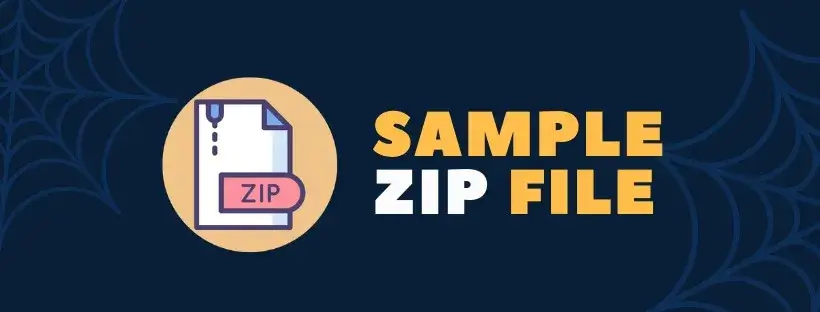Here, You can find multiple sample zip files for your testing purposes and you can download them.
Zip files are lossless data compression archive file format. ZIP files have a “.zip” extension.

Table of Contents
ToggleSample ZIP File
I have added below sample file that has 10.2 kB size. and that contains a text file.
Sample Large ZIP File
Sample TAR file download
Suggest us for more files you want to some more files for download.
What is a ZIP file:
- A ZIP file is a compressed archive that stores one or more files or folders.
- It reduces the overall file size, making it easier to store, share, and transfer files.
- It’s a common format used across various operating systems.
Key features of ZIP file:
- Compression: Minimizes file size using algorithms, often without losing quality.
- Organization: Combines multiple files and folders into a single entity for better management.
- Sharing: Facilitates easy transfer of multiple files over email, cloud services, or other platforms.
- Storage: Saves disk space by compressing files, especially helpful for large files or backups.
Common uses of ZIP files:
- File sharing: Emailing large attachments, uploading multiple files to websites, or sharing files online.
- Software distribution: Packaging software programs and their components for installation.
- Backups: Creating compressed copies of important files or folders for data protection.
- Digital downloads: Distributing music, videos, ebooks, software, and other digital content.
How to open a ZIP file:
Most operating systems have built-in tools to extract ZIP files:
- Windows: Right-click the ZIP file and select “Extract All.”
- macOS: Double-click the ZIP file to open it in the Archive Utility.
- Linux: Use a file archiver like “unzip” in the terminal.
Alternatively, use third-party software like WinZip, 7-Zip, or WinRAR for advanced features.
How to create zip file
Here’s a guide on creating ZIP files, covering common operating systems:
Windows:
- Locate the files or folders: Navigate to the files or folders you want to compress.
- Select them: Hold down the Ctrl key to select multiple items, or click and drag to select a group.
- Right-click and choose “Send to” > “Compressed (zipped) folder”: This initiates compression.
- Rename the zipped folder (optional): Right-click the new ZIP file and select “Rename” to give it a descriptive name.
macOS:
- Locate the files or folders: Find the items you want to compress.
- Control-click or right-click: Press and hold the Control key while clicking, or right-click on the selected items.
- Choose “Compress” > “File name.zip”: This creates a ZIP file with the same name as the original folder or file.
Linux:
- Open a terminal window: Press Ctrl+Alt+T or search for “Terminal” in the applications menu (Top Bar).
- Navigate to the directory: Use the
cdcommand to change to the directory containing the files to compress. - Use the
zipcommand (Linux Command): Typezip archive_name.zip file1 file2 folder1(replace with your desired names).
Additional tips to create Zip File:
- Password-protect ZIP files: Use third-party software like WinZip or 7-Zip to add password protection for security and data hidden.
- Split large ZIP files: Divide large ZIP files into smaller parts for easier sharing or storage using software like 7-Zip.
- Use cloud services: Use cloud services like Google Drive or Dropbox for storing and sharing ZIP files without manual compression and also help to store and directly link share.


Hello, I am Denail Soovy. I am a developer of different technology. I am passionate about teaching and Daily teaching many students. I want to share knowledge with all of the developers or other people who need it.
I will try to teach every student with my easy and updated blogs.
